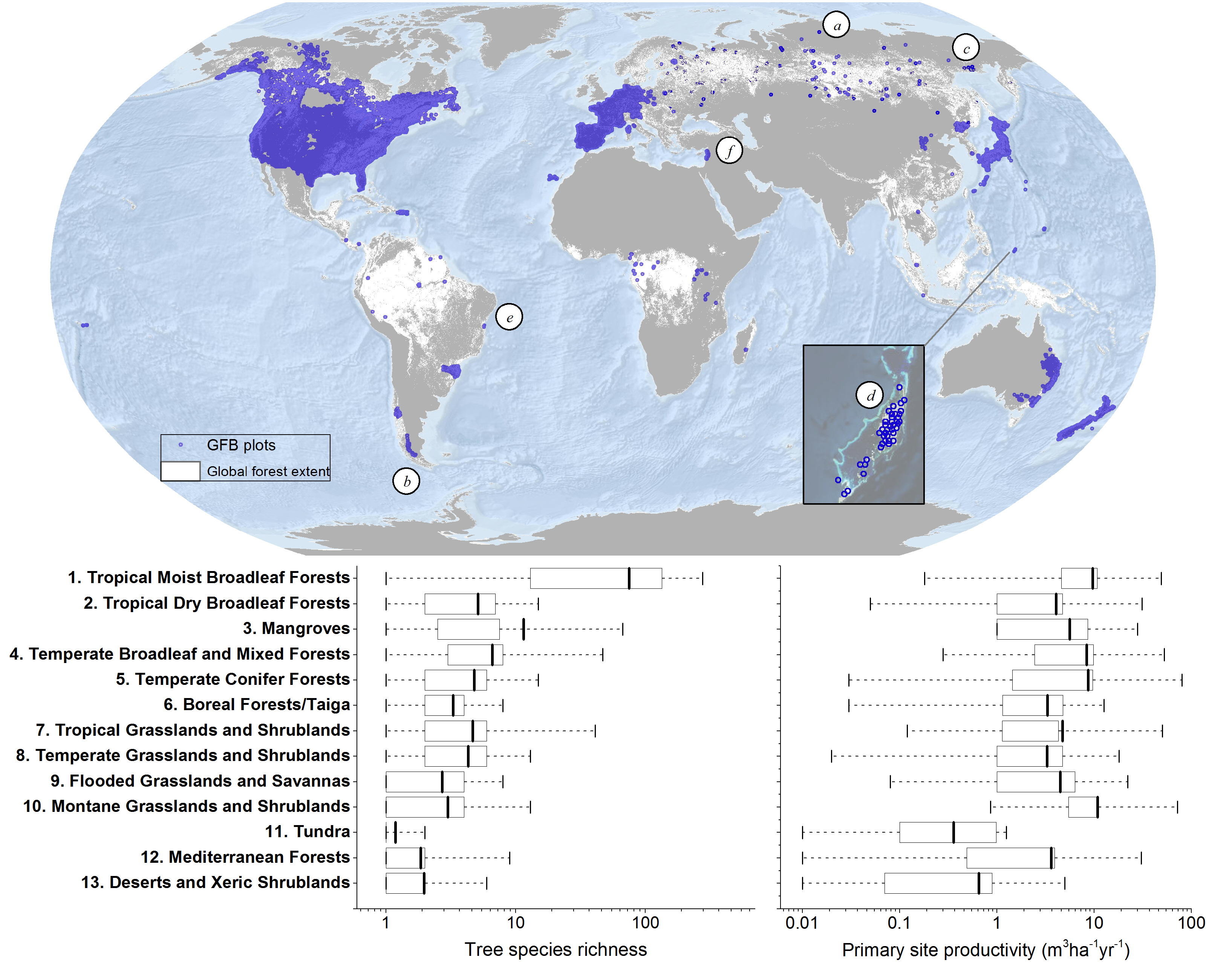1. Global geographic distribution of the elasticity of substitution (θ)
-General Information
Global geographic distribution of the elasticity of substitution (theta)
-File format:
File System Raster
Cell size: 53km by 53km
File size (unzipped): 634.48 KB
Datum: D_WGS_1984
-Data description:
The elasticity of substitution (theta) represents the degree to which species can substitute for each other in contributing to forest productivity; theta measures the marginal productivity—the change inproductivity resulting from one unit decline of species richness—and reflects the strength of the effect of tree diversity on forest productivity, after accounting for climatic, soil, and plot-specific covariates.
A higher theta corresponds to a greater decline in productivity due to one unit loss in biodiversity.
-Citation
Liang, J., T. W. Crowther, N. Picard, S. Wiser, M. Zhou, G. Alberti, E.-D. Schulze, A. D. McGuire, F. Bozzato, H. Pretzsch, S. de-Miguel, A. Paquette, B. Hérault, M. Scherer-Lorenzen, C. B. Barrett, H. B. Glick, G. M. Hengeveld, G.-J. Nabuurs, S. Pfautsch, H. Viana, A. C. Vibrans, C. Ammer, P. Schall, D. Verbyla, N. Tchebakova, M. Fischer, J. V. Watson, H. Y. H. Chen, X. Lei, M.-J. Schelhaas, H. Lu, D. Gianelle, E. I. Parfenova, C. Salas, E. Lee, B. Lee, H. S. Kim, H. Bruelheide, D. A. Coomes, D. Piotto, T. Sunderland, B. Schmid, S. Gourlet-Fleury, B. Sonké, R. Tavani, J. Zhu, S. Brandl, J. Vayreda, F. Kitahara, E. B. Searle, V. J. Neldner, M. R. Ngugi, C. Baraloto, L. Frizzera, R. Balazy, J. Oleksyn, T. Zawila-Niedzwiecki, O. Bouriaud, F. Bussotti, L. Finér, B. Jaroszewicz, T. Jucker, F. Valladares, A. M. Jagodzinski, P. L. Peri, C. Gonmadje, W. Marthy, T. O’Brien, E. H. Martin, A. R. Marshall, F. Rovero, R. Bitariho, P. A. Niklaus, P. Alvarez-Loayza, N. Chamuya, R. Valencia, F. Mortier, V. Wortel, N. L. Engone-Obiang, L. V. Ferreira, D. E. Odeke, R. M. Vasquez, S. L. Lewis, and P. B. Reich. 2016. Positive biodiversity-productivity relationship predominant in global forests. Science 354.DOI: 10.1126/science.aaf8957
-Data Use Policy
1. GFBI reserves all the rights pertaining to these data;
2. Any use of part of or the entire data set must acquire approval from GFBI by filling out an online application form at
2. GFBI Ground-Sourced Forest Inventory Data
GFBI ground-sourced data were collected from in situ measurement of over 1 million permanent sample plots consisting of over thirty million trees across over 10,000 species. GFBI plots cover a significant portion of the global forest extent (white), including some of the most unique forest conditions: (a) the northernmost (73°N, Central Siberia, Russia), (b) southernmost (52°S, Patagonia, Argentina), (c) coldest (-17°C annual mean temperature, Oimyakon, Russia), (d) warmest (28°C annual mean temperature, Palau, USA) plots, and (e) most diverse (405 tree species on the 1-ha plot, Bahia, Brazil). Plots in war-torn regions (e.g. f) were assigned fuzzed coordinates to protect the identity of the plots and collaborators. The box plots show the mean and interquartile range of tree species richness and primary site productivity (both on a common logarithmic scale) derived from ground-measured tree- and plot-level records
Metadata
Global Forest Biodiversity Initiative (GFBI)- Dataset Global#1. Data underpinning the Research Article entitled Positive Biodiversity–Productivity Relationship Predominant in Global Forests
- Citation
Liang, J., T. W. Crowther, N. Picard, S. Wiser, M. Zhou, G. Alberti, E.-D. Schulze, A. D. McGuire, F. Bozzato, H. Pretzsch, S. de-Miguel, A. Paquette, B. Hérault, M. Scherer-Lorenzen, C. B. Barrett, H. B. Glick, G. M. Hengeveld, G.-J. Nabuurs, S. Pfautsch, H. Viana, A. C. Vibrans, C. Ammer, P. Schall, D. Verbyla, N. Tchebakova, M. Fischer, J. V. Watson, H. Y. H. Chen, X. Lei, M.-J. Schelhaas, H. Lu, D. Gianelle, E. I. Parfenova, C. Salas, E. Lee, B. Lee, H. S. Kim, H. Bruelheide, D. A. Coomes, D. Piotto, T. Sunderland, B. Schmid, S. Gourlet-Fleury, B. Sonké, R. Tavani, J. Zhu, S. Brandl, J. Vayreda, F. Kitahara, E. B. Searle, V. J. Neldner, M. R. Ngugi, C. Baraloto, L. Frizzera, R. Bałazy, J. Oleksyn, T. Zawiła-Niedźwiecki, O. Bouriaud, F. Bussotti, L. Finér, B. Jaroszewicz, T. Jucker, F. Valladares, A. M. Jagodzinski, P. L. Peri, C. Gonmadje, W. Marthy, T. O’Brien, E. H. Martin, A. R. Marshall, F. Rovero, R. Bitariho, P. A. Niklaus, P. Alvarez-Loayza, N. Chamuya, R. Valencia, F. Mortier, V. Wortel, N. L. Engone-Obiang, L. V. Ferreira, D. E. Odeke, R. M. Vasquez, S. L. Lewis, and P. B. Reich. 2016. Positive biodiversity-productivity relationship predominant in global forests. Science 354.
- Header Definition and Units
See Table 1 of the citation above
- Data Use Policy
- GFBI reserves all the rights pertaining to these data;
- Prior to any use of part of or the entire data set, one must fill out the accompanied Data Use Agreement and email the signed form to
For other attributes and/or tree-level data, please fill out the Data Request Form.



